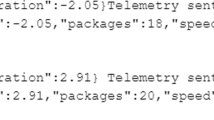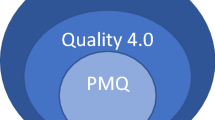Abstract
Today, manufacturers are measured by their ability to respond quickly to sudden, often unpredictable changes in customer needs and wants. Competition beyond the twenty-first century places an increased emphasis upon receiving business information that is accurate and up to date. In order to achieve this, a business planning and closed-loop manufacturing execution system must reflect how work is done, in order to support the overall business objectives without being limited by any hardware, software and human resource constraints. Enterprise resources planning (ERP) is considered to be the most effective computer application in the modern manufacturing industry which meets these requirements. However, only a few manufacturers can design and implement the system successfully. They encounter various problems during the design and implementation cycle. One of the major reasons why they cannot implement the system successfully is the inappropriate use of design and implementation methodology. A systematic design and implementation methodology is therefore proposed for ERP. Called the hierarchical design pyramid (HDP), it encompasses recent research on the ICAM definition method (IDEF) and the object-oriented methodology (OOM) as well as an architecture for any manufacturers who seriously consider ERP implementation.
Similar content being viewed by others
References
Ang, J. S. K., Sum, C. C. and Yang, K. K. (1994) MRPII com-pany profile and implementation problems: a Singapore ex-perience. International Journal of Production Economics, 34, 35–45.
Ashworth, C. and Goodland, M. (1990) SSADM: A Practical Approach, McGraw-Hill, Maidenhead.
Benjamin, P. C., Mayer, J. R. and Graul, M. (1993) An integrated approach to cost benefit analysis in Proceedings of IDEF and the Corporate Infrastructure, University of Maryland, IDEF Users Group, Kettering, OH, pp. 174–180.
Booch, G. (1994) Object-Oriented Analysis and Design with Ap-plications, 2nd edn, Benjamin/Cummings.
Burns, O. M. and Turnipseed, D. (1991) Critical success factors in manufacturing resource planning implementation. Interna-tional Journal of Operations and Production Management, 11 (4), 5–19.
Coad, P. (1991) Object-Oriented Analysis, Yourdon.
Colquhoun, G. J., Gamble, J. D. and Braines, R. W. (1989) The use of IDEF0 to link design and manufacture in a CIM en-vironment. International Journal of Operations and Produc-tion Management, 9(4), 48–65.
Cox, J. F. and Clark, S. J. (1984) Problems in implementing and operating a manufacturing resource planning information system. Journal of Management Information Systems, 1(1), 81–101.
Cutts, G. (1991) Structured Systems Analysis and Design Metho-dology, Blackwell Scientific, Oxford.
DeMarco, T. (1979) Structured Analysis and System Specification, Yourdon.
Dewhurst, S. C. and Stark, K. T. (1995) Programming in C++, 2nd edn, Prentice Hall, Englewood Cliffs, NJ.
Design/IDEF User's Manual for MS Windows
Eswara, R. C., Krishnauah, C. and Chaudhuri, D. (1992) A Petri net based approach for analyzing tool management issues in FMS. International Journal of Production Research, 30(6), 1427–1446.
Gane, C. and Sarson, T. (1979) Structural System Analysis: Tools and Techniques, Prentice-Hall, Englewood Cliffs, NJ.
Hargrove, S. K. (1995) A systems approach to fixture planning and design. International Journal of Advanced Manufacturing Technology, 10, 169–182.
Hill, S. C. (1995) A Concise Guide to the IDEF0 Technique: A Practical Technique for Business Process Reengineering, Enterprise Technology Concepts Inc., Puyallup, WA.
Jacobson, I. (1992) Object-Oriented Software Engineering: A Use Case Driven Approach, Addison-Wesley, Reading, MA.
Lau, K. H. and Ip, W. H. (1993) Implementation of an MRP system: a case study of a Hong Kong manufacturing com-pany in Proceedings the Sixth International Manufacturing Conference with China, 2, pp. 555–560.
Martin and Odell (1992) Object-Oriented Analysis and Design, Prentice Hall, Englewood Cliffs, NJ.
Martin, R. (1995) Turbocharging MRPII systems with enterprise synchronisation, IIE Solution, November, pp. 32–34.
Meyer, B. (1988) Object-Oriented Software Construction, Prentice Hall, Englewood Cliffs, NJ.
Ormsby, J. G., Ormsby, S. Y. and Ruthstrom, C. R. (1990) MRPII implementation: a case study. Production and Inven-tory Management Journal, 4, 77–80.
Robert, G. (1996) Beyond ERP and MRPII, IIE Solution, Sep-tember, pp. 32–35.
Ross, T. D. (1977) Structured analysis (SA): a language for communicating ideas. IEEE Transactions on Software Engi-neering, 3(1), 16–35.
Ross, T. D. (1985) Applications and extensions of SADT. IEEE Transactions on Computer Science, 18, 25–34.
US Air Force Integrated Computer-Aided Manufacturing (ICAM) Architecture Part II, Vol. IV, Functional Modelling Manual (IDEF0). AFWAL-TR-81-4023, Air Force Materials Lab-oratory, Wright-Patterson Air Force Base, OH.
US Air Force Air Force Computer Aided Manufacturing (AF-CAM) Master Plan. AFML-TR-74-104, Wright-Patterson Air Force, Base, OH.
Van Der Aalst, W. M. P. and Van Hee, K. M. (1994) Putting Petri nets to work in industry. Computers in Industry, 25(1), 45–54.
White, E. M., Anderson, J. C., Schroeder, R. G. and Tupy, S. E. (1982) A study of the MRP implementation process. Journal of Operations Management, 2(3), 39–47.
Wight, O. W. (1981) MRPII — Unlocking America's Productivity Potential, CBI Publishing, Boston.
William, O. T., Hagelstein, J., Macdonald, I. G. and Rolland, C. (1991) Information Systems Methodologies — A Framework for Understanding, Addison-Wesley, Reading, MA, p. 181.
Wirfs-Brock and Wilkerson (1990) Designing Object-Oriented Software, Prentice Hall, Englewood Cliffs, NJ.
Wisnosky, D. E. (1987) ICAM-foundation for next generation factories. Industrial Engineering, 4, 38–45.
Zhang, H. C. and Alting, L. (1991) Trends in integrated manu-facturing. Manufacturing Review, 4(3), 173–181.
Author information
Authors and Affiliations
Rights and permissions
About this article
Cite this article
Ng, J.K.C., Ip, W.H. & Lee, T.C. The development of an enterprise resources planning system using a hierarchical design pyramid. Journal of Intelligent Manufacturing 9, 385–399 (1998). https://doi.org/10.1023/A:1026409806874
Issue Date:
DOI: https://doi.org/10.1023/A:1026409806874




